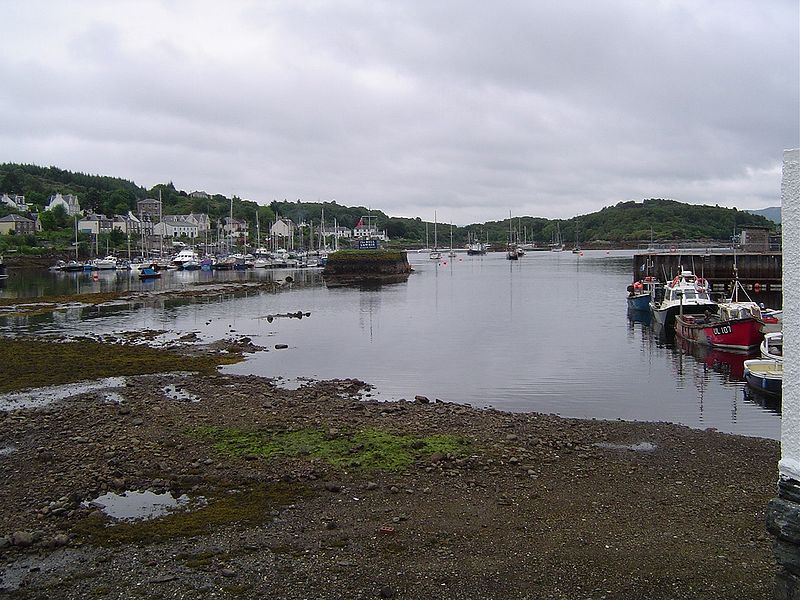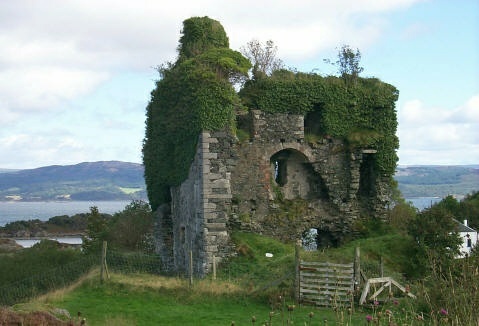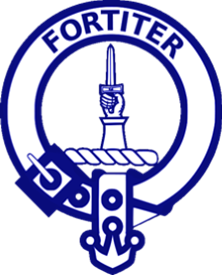Colonel McAlester of Tarbert
By Ian McDonald
Sheanakill, Clachan, Tarbert, Argyll PA29 6XL Scotland, UK
© 1984 - 1985
Preface
by Robert C. McAllister
March 1999
Ever since the Clan McAlister of America (CMA) was founded in 1990, its principal effort has been to research and construct genealogies for each American and Canadian family whose progenitors were named McAlister, or a spelling variation of it. There are now over 200 such family lines in the CMA. Many years before the CMA came into existence, McAlisters from the United States have visited Scotland and Ireland in search of their ancestral families. One such visit was made in the 1980s by Ted K. and Barbara McAlister. Ted's line has been identified as AM01, (Andrew Matthew and Nancy West McAllister) but at that time, he believed that he was descended from the A01 line (Angus and Margaret Boyce McAllister). One of his efforts to find out more was to commission Captain Ian MacDonald of Clachan, Tarbert, in Kintyre to write studies of the McAlisters who lived in the area of Scotland from which most our ilk originated. One of those articles appears below.
Research conducted by CMA members has consisted of assembling and comparing information about the McAlister families in Scotland from many sources. In summary, we have learned that the Clan Alasdair was founded in the thirteenth century by Alasdair Mor, second son of Donald of the Isles, founder of the Clan Donald. We have also learned that there are four septs, or separate families, in the Clan MacAlasdair (son of Alasdair): Loup; Alexanders of Menstrie; Tarbert; and Glenbarr.
At first, the family was known as the McAlisters of Loup, a name first used by Alexander MacAlasdair, a grandson of Alasdair Mor.
The Tarbert McAlister sept was founded by Donald Macalister, second son of Angus Vic Ianh Dubh (Angus John) of the Loup, an eighth generation descendant of Alasdair Mor. Finally, the Glenbarr McAlister sept was founded by Ranald Mor MacAlister of Dewpin in the sixteenth century. No genealogical work has yet been done by the CMA on the Alexander of Menstrie sept.
The following article uses some Scottish terms that may be unfamiliar to some readers. For instance, a "sasine" is the act of giving possession of feudal real property. A "precept of clare constat" is an instrument by which legal ownership of land is transferred. Legally, it is a deed executed by a subject-superior for the purpose of completing the title as his vassal's heir to the lands held by the deceased vassal, under the grantor of the precept. These are admittedly obscure terms which mean very little to a modern American. They are used by Scottish researchers for precise meaning. The abbreviation 2/ means two shillings. The "MS" abbreviation used in the list of references means manuscript. The place names in the references are towns in Kintyre where the Scottish MacAlisters lived before their descendants came to America. Ballinakill was the home of Coll McAllister, a son of Ronald McAllister of Dunskeig. Coll sold the place to Colin Campbell of Skipness on his departure for North Carolina in 1739.
A Famous Colonizer from Tarbert McAlisters:
Colonel Alexander McAlister, son of Coll McAlester of Balinakill
By Ian McDonald
 As described in a previous article in the Journal (see Volume 1, No. 2), Archibald McAlister of Tarbert, in 1698, purchased the estate of Balinakill, Clachan and later it was purchased by his younger brother Ronald McAlister of Dunskeig in 1717. He and his wife had a family of at least three sons: Coll, John and Robert. John became a surgeon, but little can be found of Robert who, however, was recorded as witness to a document at Lochgair in 1724, in respect of a declaration by Hector McAlister of Loup. Coll, the eldest, sold Balinakill in 1739, and emigrated to North Carolina. At this time, 5 Scottish gentlemen and some 90 poor families totaling 350 souls in all, sailed from Campbelltown and Gigha on 6 June 1739 on the ship "Thistle" of Saltcoats, Ayrshire. The old Campbelltown Customs records show the ship to be "embarking passengers for Cape Fair." The other four gentlemen were McNeills and Campbells and were mostly relations by marriage.
As described in a previous article in the Journal (see Volume 1, No. 2), Archibald McAlister of Tarbert, in 1698, purchased the estate of Balinakill, Clachan and later it was purchased by his younger brother Ronald McAlister of Dunskeig in 1717. He and his wife had a family of at least three sons: Coll, John and Robert. John became a surgeon, but little can be found of Robert who, however, was recorded as witness to a document at Lochgair in 1724, in respect of a declaration by Hector McAlister of Loup. Coll, the eldest, sold Balinakill in 1739, and emigrated to North Carolina. At this time, 5 Scottish gentlemen and some 90 poor families totaling 350 souls in all, sailed from Campbelltown and Gigha on 6 June 1739 on the ship "Thistle" of Saltcoats, Ayrshire. The old Campbelltown Customs records show the ship to be "embarking passengers for Cape Fair." The other four gentlemen were McNeills and Campbells and were mostly relations by marriage.
Recent research uncovered the complete document signed by Coll McAlester and later by Janet McNeill, his spouse, at Skerrols in Islay on 10 May 1739. An old letter which has survived records the ship at Gigha taking on more passengers. This was written by John McAlister of Cown to his relatives in North Carolina. In 1740 all these gentlemen were given large land grants and exemption from taxes together with a money grant to help establish themselves in their new country. This was the first large emigration of Scots settlers to America recorded, and all came from the mainland of Kintyre and the adjacent islands of Islay, Gigha and Jura.
Coll McAlister and Janet McNeill had a family of two sons: Alexander, born in 1715, and Hector born in 1716, together with three daughters, Grissella, who died unmarried, Isabella, who married Farquhard Campbell and Mary, who married Hector McNeill. Alexander McAlister was thrice married. His first wife died shortly after their marriage and was buried at sea on a return voyage to Carolina in 1740. They had no children. His second wife was Flora McNeill, a daughter of Neill McNeill and Grissella Campbell. They had four children: Coll, Grissella, Janet and Neill. His third wife was Jane Colvin who was, according to historians, born at sea when her parents emigrated in 1740. This marriage was recorded on July 14, 1763. In letters preserved between Alexander and his brother Hector on the island of Arran, he gives details of his family. Alexander, later Colonel Alexander McAlister, became a great patriot and became a prominent figure in North Carolina, becoming a member of the N.C. Senate in 1787. A monument erected to his memory commemorates his many achievements.
 Hector McAlister returned to Scotland after selling off his estates and settled on the island of Arran, adjacent to east Kintyre. The Jacobite rebellion was soon to break out all over western Scotland and he, being true to the Stuart cause, was given money to raise a force of men to support Prince Charles Edward Stuart. This force was unable to leave the island since Archibald McAlister of Tarbert was an ardent Hanoverian, and despite the fact that his Clan Chief Angus McAlester of Loup supported the Jacobite cause, Tarbert allowed Lord Loudon's regiment to be stationed at Tarbert to prevent anyone from sailing to join Prince Charles. Hector McAlister was denounced as a rebel and Government forces ordered to apprehend him. Those apprehended were to be imprisoned in Dumbarton Castle near Glasgow. After many months in hiding among the hills of Arran, he evaded capture and was later pardoned. On one occasion he was hiding underneath some straw bales in a barn when soldiers searched it, but although they prodded the bales with their pikes, he was not detected or injured. He was later pardoned in 1746 and married Mary Fullarton of Corseby, Ayrshire, a daughter of an old Norman family. This family had extensive lands near Ayr. He was given the tenancy of the farms of Monyquil and Glaister, and became a prominent member of the island community. He was also a member of the committee instrumental in getting a ferry service from Arran to the mainland. The family born in Arran consisted of one son, Charles, and five daughters.
Hector McAlister returned to Scotland after selling off his estates and settled on the island of Arran, adjacent to east Kintyre. The Jacobite rebellion was soon to break out all over western Scotland and he, being true to the Stuart cause, was given money to raise a force of men to support Prince Charles Edward Stuart. This force was unable to leave the island since Archibald McAlister of Tarbert was an ardent Hanoverian, and despite the fact that his Clan Chief Angus McAlester of Loup supported the Jacobite cause, Tarbert allowed Lord Loudon's regiment to be stationed at Tarbert to prevent anyone from sailing to join Prince Charles. Hector McAlister was denounced as a rebel and Government forces ordered to apprehend him. Those apprehended were to be imprisoned in Dumbarton Castle near Glasgow. After many months in hiding among the hills of Arran, he evaded capture and was later pardoned. On one occasion he was hiding underneath some straw bales in a barn when soldiers searched it, but although they prodded the bales with their pikes, he was not detected or injured. He was later pardoned in 1746 and married Mary Fullarton of Corseby, Ayrshire, a daughter of an old Norman family. This family had extensive lands near Ayr. He was given the tenancy of the farms of Monyquil and Glaister, and became a prominent member of the island community. He was also a member of the committee instrumental in getting a ferry service from Arran to the mainland. The family born in Arran consisted of one son, Charles, and five daughters.
Charles McAlister was drowned in 1774 when, on a journey from Arran to Islay with one of his sisters, he had a sword fight with the captain of the ship who had molested his sister. His body was recovered near Davaar Island, Campbelltown, and is buried in the family vault in Kilbride Cemetery, Lamlash, together with his father Hector, two sisters and brother-in-law Neil Shannon of Lephenstrath, Kintyre. Hector died in 1790, aged 74 years. He wrote a lament for his son who (I should have added) was thrown overboard on the orders of the Captain, who was named James Hamilton. The inscription on the stone in Kilbride, Lamlash, Arran reads, " The burying tomb of Hector McAlister, Esquire of Springbank died A.D. 1790 aged 74 years, and Elizabeth McAlister, his daughter she died 1769 aged 23 years. Also Charles McAlester his son died 1774 aged 24 years. "
Springbank House, where Hector was living in 1780, still stands in a prominent position above Brodick Bay, and this old two storied house with its farm buildings and carved name on the west wall remains a monument to the last of the descendants of the male line of Ronald McAlester of Dunskeig. The lament, translated from the Gaelic reads:
Handsome and shapely thy form and royal thy speech,
In truth was thy pleasure, thy displeasure in deceit,
Thy yellow hair so wavy, curly and bunchy,
Thy bright blue eye so winning in thy head.
Many a lady dressed in silk and grandeur,
Twixt Arran and Islay and Kintyre of the kine,
Would give the world to have thee as their own,
And they all in sorrow so young thou didst die.
Thy father and thy mother are each day under grief,
With nought in the world to compensate the loss,
Until they reach the place where all sorrow is dispelled,
Where no bitter tear will ever moisten their cheek.
Oh! the pity on those who true companions don't choose,
Who would fear the Lord on sea or on land,
To him his bread would be sure and his water be pure,
And at the end of his days he happy would be.
--End--
In truth was thy pleasure, thy displeasure in deceit,
Thy yellow hair so wavy, curly and bunchy,
Thy bright blue eye so winning in thy head.
Many a lady dressed in silk and grandeur,
Twixt Arran and Islay and Kintyre of the kine,
Would give the world to have thee as their own,
And they all in sorrow so young thou didst die.
Thy father and thy mother are each day under grief,
With nought in the world to compensate the loss,
Until they reach the place where all sorrow is dispelled,
Where no bitter tear will ever moisten their cheek.
Oh! the pity on those who true companions don't choose,
Who would fear the Lord on sea or on land,
To him his bread would be sure and his water be pure,
And at the end of his days he happy would be.
--End--
Sources of reference and information:
- Clan Donald - Vol. 1,2 & 3 - Revs. A. MacDonald
- Clan Donald - Donald J. MacDonald of Castletown.
- The Book of Islay - Courtesy of J. R. MacDonald of Largie.
- Kilcalmonell Old Parish Records - Register House, Edinburgh.
- Register of Sasines (Argyll). Argyll & Bute District Council, per Mr. M. MacDonald, Archivist.
- Kilcalmonell Kirk Session Records - Unpublished MS.
- Kintyre Antiquarian Society Library
- Glasgow University - List of Students - Argyll & Bute District Archives.
- Clan Donald Family tree by John Brown - genealogist to the Prince Regent, Prince Albert - Courtesy of J. R. M. MacDonald of Largie.
- The Map Room - National Library, Edinburgh.
- Kintyre in the 17th Century - A. McKerral.
- Record of Commissions of Supply, Argyll (1744) - Argyll & Bute District Archives.
- Loup MS, 1573 - 1950 - Unpublished MS.
- Balinakill MS, 1698 - 1867
- Memorial of the Forty five - Unpublished Glenbarr MS - Courtesy of Angus Macalister of Glenbarr.
- Loup Estate rental books - Unpublished MS.
- Balinakill Estate rental book - Unpublished MS.
- Glencoe Museum - MacDonald Family Tree - Miss B. Fairweather.
- Torrisdale Estate, Loup Estate, Balinakill Estate and Inveryne Estate - Unpublished MS by G. Langlands, Surveyor.
- Records of Synod of Argyll, 1639 - 1651 - Duncan C. MacTavish.
- Sir Donald McAlister of Tarbert - Lady Edith McAlister. Book supplied by Mr. C. Sutherland, Tarbert.
- Torrisdale Family Tree - Courtesy of D.S. Macalister - Hall of Torrisdale.
- Glenbarr Family Tree - Courtesy of Angus C. Macalister of Glenbarr.
- McAllister letters and McNeill letters - Courtesy of Ben M. Huckabay, Jr., Antlers, Oklahoma, USA.

